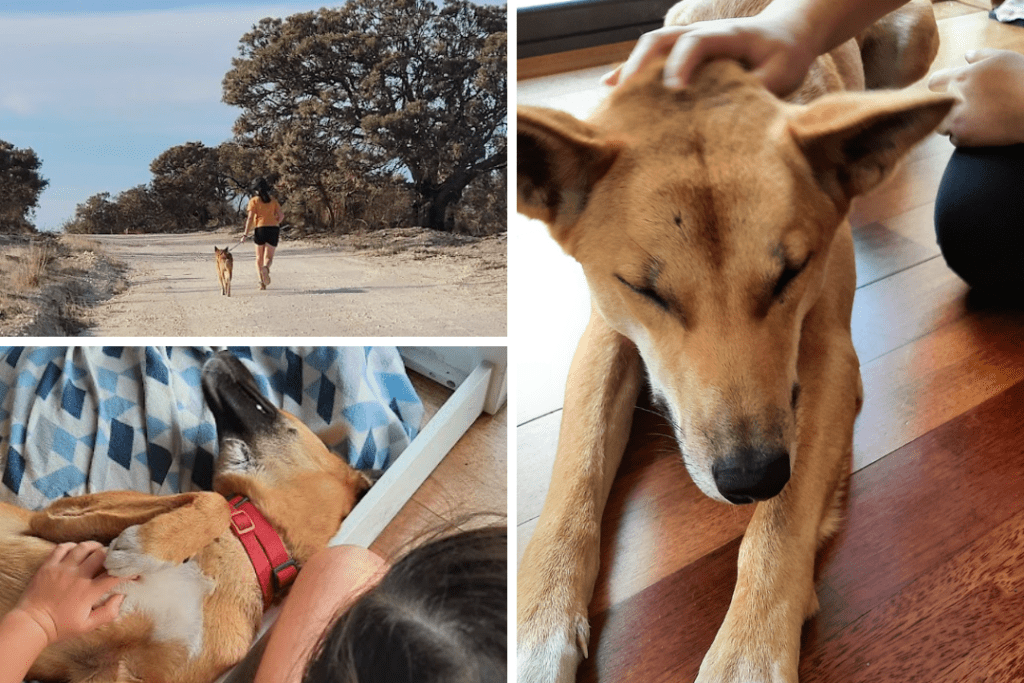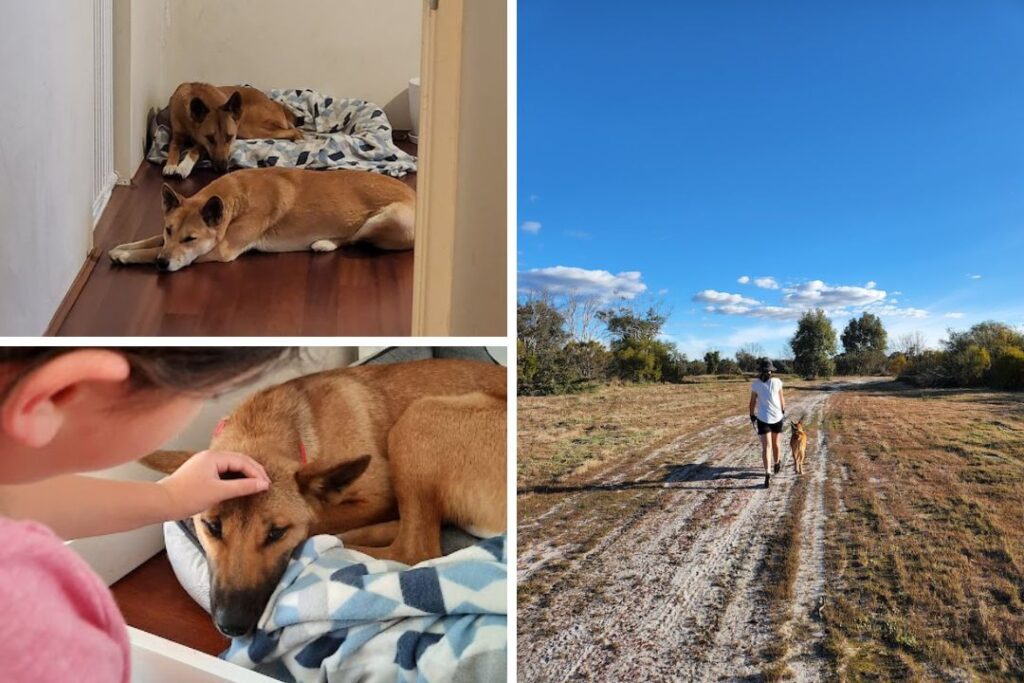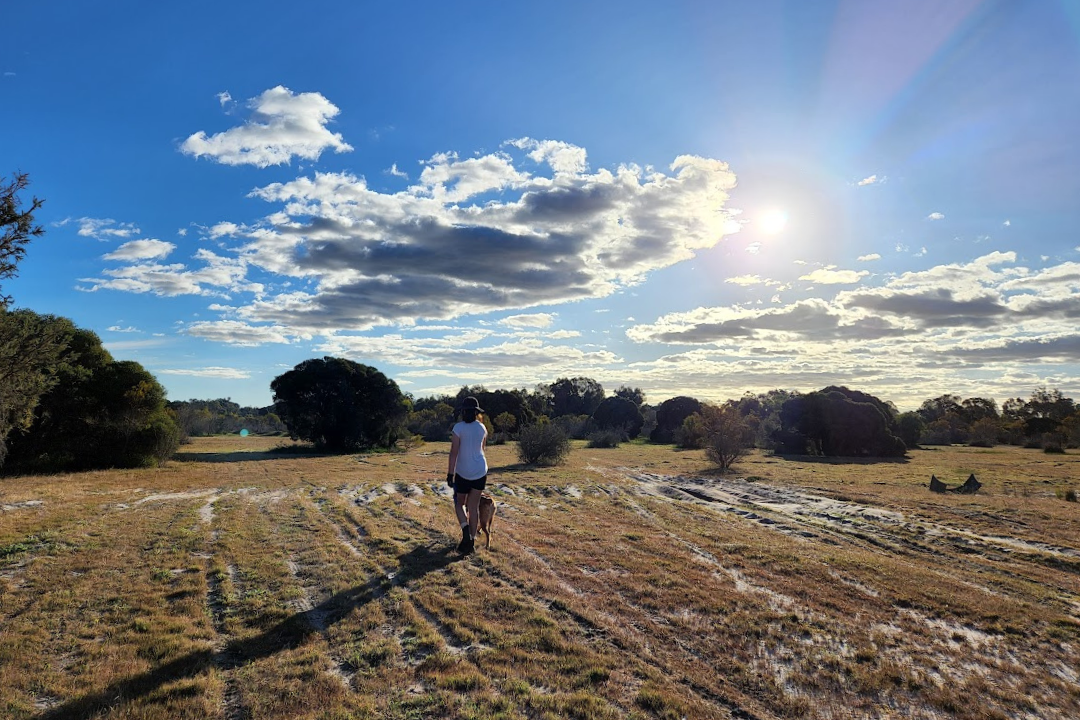Dingoes and children are a controversial mix. From “a dingo stole my baby” to dingo attacks at K’gari, there’s a fair amount of bad news out there when it comes to dingoes and kids. Thankfully, it’s not all bad news.
If you have children and you’re thinking of adopting a dingo, this article is for you.
Before we adopted our dingoes, we researched as much as we could. At the time, we had two teenagers and a ten year old, and now, our family includes two adopted wild-born dingoes. They are beautiful — truly incredible — and we love them to bits. Below, I’ll share my experience as a parent and dingo guardian.
Why do dingoes need adoption?
Australian dingoes belong in the wild, but too often, dingoes are orphaned, injured or taken from their homes. Unfortunately in many parts of Australia, it is legal to poison, trap and shoot dingoes. Dingoes become displaced from their family units and are unable to care for themselves or be released back into the wild after being rescued or after receiving medical treatment.
Dingo and animal rescue organisations around Australia are consistently inundated with dingoes who need a new home. Some are wild-born whilst others have been in homes previously and need to be rehomed. Some of these dingoes find a permanent home at dingo sanctuaries around Australia such as:
There are a small number of dingo sanctuaries around Australia, who go above and beyond caring for displaced dingoes, but as you can imagine, sanctuaries can only take so many dingoes, and the rest need to find homes through adoption.
Can I adopt a dingo as a *pet?
Before you adopt a dingo, the first thing to check is if it’s legal where you live. Adopting a dingo is not possible in some parts of Australia and other locations have very specific requirements to ensure dingoes are given the right care.
Currently in Western Australia, there are no restrictions when it comes to adopting dingoes, other than laws applicable to domestic dogs, such as microchipping, registration, using a lead and ensuring our property is secure.
Should I adopt a dingo?
There are a number of factors to consider when choosing to adopt a dingo. You’ll need to consider the unique characteristics of dingoes as well as your own personal circumstances. For example, dingoes in domestic environments can live 15-20 years and travelling with a dingo can be very different to travelling with a dog.
You can find more information about adopting a dingo here:
- Adopt a dingo: one reason you might want a dingo – Intrepid World
- 10 reasons not to get a dingo – Intrepid World
- Dingo Den Animal Rescue

Adopting a dingo when you have children
Adoption listings for dingoes usually include a recommendation or requirement that their prospective family should not have children under a certain age. This is due to the size and maturity of children, the environment created by children and also due to the nature of each individual dingo.
The age recommendation varies, sometimes children aren’t an issue, but most times the recommended age will be 10, 12 or even 16 years old and above. Sometimes the recommended age of children can be as low as 5 years old, or they might not be mentioned at all. In Victoria, as a permit holder, children under the age of 16 are not allowed unsupervised access to a pet dingo.
Keep in mind that all dingoes are different, they each have their own personalities and circumstances that shape who they are and their temperament.
This may be a bit dark…. but…
Whilst dingoes are in need of adoption, it’s important to remember that a dingo is an apex predator. Dingoes eat meat. In the wild, they hunt: they work together to take down prey, or they work alone to detect and find their own meal.
Will your dingo make a meal out of you? The Dingo Den says no: “Dingoes who recognise humans as companions will not hunt humans. Wild dingoes who do not have a relationship with humans may inquire if a human is a food source.”
So if you’re thinking of dingo incidents at K’gari (Fraser Island), this is a different context to having dingoes in your home. Dingoes at home will develop a relationship with you, be well fed and will know that you and your children are not a food source.
Before we go any further, here’s an important reminder to never approach a wild dingo, never feed a wild dingo and never, ever take a dingo from the wild.

Why are dingoes not a good idea when you have young children?
Dingo size and playfulness
Dingoes are comparable to medium sized dogs. When they live in domestic environments, it’s common for adopted dingoes to weigh 15-20kg. At their last weigh-ins, Jalba was 18kg but still growing and Rusty was just over 20kg.
Their size and playful nature mean that young children can be easily knocked over during playtime and potentially injured. No doubt you’ve seen two dogs playing outside or doing zoomies in the house — well, dingoes do the same! They sprint, jump and play fight — it’s incredible to watch.
Children’s maturity and self control
One of the most important factors when it comes to children and dingoes in the home, is that children don’t necessarily have the maturity or self-control to be safe around dingoes without supervision, especially toddlers and young children.
Dingoes need a lot of space, especially from strangers and children. Children make a lot of noise, move with less predictability and may not recognise a dingo’s signs of distress.
Children (think of toddlers!) are more likely to hug a dingo, lean on, climb on or get in a dingo’s space when it’s not wanted, such as when they are sleeping or eating. Just like with dogs, this is a recipe for disaster — nobody wants an injured child or dingo, or the consequences that may follow.
Dingoes are often fluffy and adorable, they sleep a lot and they’re a novelty — it’s easy for children (or visitors!) to want to interact with dingoes, but dingoes may not want to interact with them.
Vigilance is so important — even with regular reminders, we’ve seen older children reach out to pat when our dingoes were not ready, and Jalba showed his discomfort by displaying a warning nip.
Dingoes are generally not like affectionate dogs that enjoy being picked up, held and cuddled. Dingoes can be aloof and particular about when and how they obtain affection, something which young children may not be able to understand.
I cannot emphasise this enough: recognising a dingo’s signs of discomfort are essential, but young children (and adults!) may struggle to see these signs.
Dingoes aren’t dogs but they share some behavioural characteristics with other canines, for example, they express anxiety or discomfort through:
- Licking their lips
- Yawning
- Moving or leaning away
- Nipping or swiping with their teeth
- Whale eye
- Raised shackles
- Chuffing
- Pacing
- Hiding or getting down on their haunches
- Fleeing
Dingoes need calm, predictable environments
Okay dingo guardians, correct me if I’m wrong. Dingoes need to live in calm, predictable environments, or at the very least, have their own safe space. Dingoes have a strong fight or flight response, they are wary of their environments and will respond if they don’t feel safe.
It’s true that children can be calm and predictable, that dingoes sleep a lot and a dingo may adjust to having children at home. They might get used to children running, jumping, playing, shouting, banging, crying and dropping food everywhere. It could work, and some people make it work, but our dingoes are easily frightened by sudden movements, new people and unusual objects (even a tissue in my hand!).

How old was our youngest child when we adopted our dingoes?
When we adopted Rusty and Jalba, our youngest child was 10, and we also had a 14 and 16 year old. Our youngest child is tall for her age, she’s confident handling horses and is assertive.
In the early days, she needed frequent reminders not to hug or lean on our dingoes or approach them while they were sleeping. These days, Rusty and Jalba love a gentle hug, but only short ones!.
Our youngest child is a gentle but firm dingo guardian. She brushes them, prepares their food, feeds them and cleans up afterwards. She walks our dingoes, trains them, sits with them, cleans up after them, she even keeps them in line. If we haven’t walked our dingoes, she even helps them burn energy with the flirt pole.
Now, at 12 years old, she is better at recognising their signals, knowing what they want, and maintaining the right boundaries.
When we first adopted our dingoes, and even now, we take care to ensure she is never completely alone with our dingoes. She might be in a room alone with them or outside alone, but one of us is always keeping an ear out or watching in case our dingoes become too playful.
The odds of anything bad happening are very low but we like to be careful, especially since dingo behaviour can change quickly if you bring certain things into the equation (like raw meat, a bbq chicken or if the dingoes get into each other’s space). Our concern is not that they will attack her, but that they might fight with each other. Again, the odds are low.
How do our dingoes behave with young visitors?
It varies. With some children (and adults), after the initial meet and greet, our dingoes are quite calm, but we always take care to remind them not to pat or feed our dingoes, even if the dingoes approach.
Rusty is more open to pats from children whereas Jalba takes a lot longer to warm up to people — he tends to approach and sniff, which children can mistake as an invitation to pat.
Rusty is generally less jumpy and will happily go and sleep in his corner, but Jalba can be quite distracted by young children and the excitement that children exhibit. We would never leave other people’s children alone with our dingoes — we are always very close by.
Should I adopt a dingo if I have a baby in the house?
Just as there is with domestic dogs, there is an element of risk when it comes to dingoes, babies and children. Every dingo is unique and every family is unique. Animal rescues may be hesitant to send a dingo to home where there is a baby, as the dingo may be at high risk of needing to be re-homed.
Dingoes and babies might work if there is a very clear physical separation of dingoes and baby, such as when dingoes have their own den and enclosure outside, and never (or rarely) come inside. Dingoes like to be part of the family, so ours live inside and out.
As mentioned, every dingo and family is different, and it can work. It depends greatly on the dingo’s temperament, your family and your home. There is at least one family in Australia who adopted a dingo, then had a baby and they seem to be making it work. There are also families who have very young children and dingoes. Based on what our children were like when they were young, I can see how it can work, but I would never leave a dingo unattended with a baby or young child.
Dingo adoption: do children and dingoes make a good mix?
Personally, I wouldn’t have adopted dingoes if our children were younger, unless we had a property where our dingoes had a completely separate den and enclosure.
If you have children in your home and you’re thinking of adopting a dingo, it might work. The general consensus is that young children and dingoes do not mix in a domestic environment, but discuss it with your animal rescue or adoption agency if you are keen to adopt a dingo.
*Dingoes belong in the wild and referring to dingoes as “pets” tends to undermine everything about a dingo. They are loyal companions but many families consider themselves as dingo guardians, not dingo owners. We’re here to care for them and provide a safe haven.

0 Comments